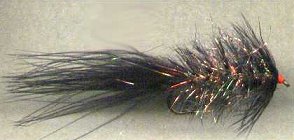
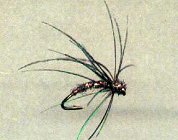
In the mood for tying up something simple--and simply “killing?” Here are two flies that take only moments to tie yet are among the most effective flies you could flip into the water: the Secret Wooly Bugger and the Secret Soft Hackle Wet Fly.
The first is a twist on one of the best known and most used flies around the world: our old friend, the Wooly Bugger. This variation uses a body of olive GSS (Gartside’s Secret Stuff) dubbed onto the shank and picked out to blend with the hackle, creating a shimmering and alluring rendition of an old theme.
The second is a simple wet fly of the soft-hackle type that also uses GSS. a slender body and head with a single turn of iridescent peacock body feather or black pheasant neck feather for a hackle. Fished just beneath the surface on a swinging line or dead-drifted upstream, this dark little fly is well worth adding to your arsenal of effective flies.
For those unfamiliar with Gartside’s Secret Stuff, this material is available from me on this Web site.
Tying the Secret Wooly Bugger
| Hook: |
Mustad 79580, Daiichi 1720 or similar 3xl streamer hook, sizes 2-12 |
| Thread: |
Red or black 6/0 Danville’s |
| Tail: |
Black marabou fibers |
| Body: |
Olive GSS |
| Ribbing: |
Black saddle feather |
| Topping: |
Fluorescent Silver Doctor Blue Marabou |
| Collar: |
Mallard flank feather |
| Body: |
Dubbed and picked out strands of Pearl GSS |
Tying Note: For an even simpler “Secret” Wooly Bugger, dispense with the hackle ribbing entirely, creating your “hackle” with picked out strands of GSS. In addition to the Black/Olive Bugger described here, you may want to try tying this using different tail and hackle colors as well; Brown or Tan-dyed Grizzly Hackle and a Brown or Tan tail is another of my favorite color combinations.
 Tie on tail just before bend of hook. Tail may be slender or full, long or short, depending on preference.
Tie on tail just before bend of hook. Tail may be slender or full, long or short, depending on preference.
 Tie in hackle at base of tail (I prefer to tie it in by the tip so that I end up with some marabou-like base fluff up near the head). Carry thread forward to a point just behind the eye.
Tie in hackle at base of tail (I prefer to tie it in by the tip so that I end up with some marabou-like base fluff up near the head). Carry thread forward to a point just behind the eye.
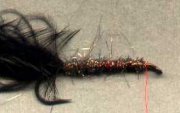 With your fingers, break up the 8” long GSS strands into shorter lengths and dub on a small amount of this onto your thread. Wind this on over shank, working towards the rear of the hook right up to the base of the tail and then back again to a point just short of the eye. This is to provide a base for the thicker portion of the body to be applied next.
With your fingers, break up the 8” long GSS strands into shorter lengths and dub on a small amount of this onto your thread. Wind this on over shank, working towards the rear of the hook right up to the base of the tail and then back again to a point just short of the eye. This is to provide a base for the thicker portion of the body to be applied next.
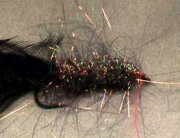 Dub a larger amount of GSS onto your thread and repeat step number 3, now winding a much thicker dubbing towards the rear and to the base of the tail and then back again to a point just short of the eye, being sure to secure the GSS strands at numerous points along the shank.
Dub a larger amount of GSS onto your thread and repeat step number 3, now winding a much thicker dubbing towards the rear and to the base of the tail and then back again to a point just short of the eye, being sure to secure the GSS strands at numerous points along the shank.
 Wind hackle forward over body to a point just behind the eye and tie off.
Wind hackle forward over body to a point just behind the eye and tie off.
With a bodkin or needle, pick out GSS at various points around the body between the windings of hackle and then --with an eyelash groomer or similar tool-- rake and comb the body so that GSS blends rather evenly with the hackle. If GSS hairs are too long- -longer than the hackle, say--simply break the tip of the strands off with your fingers until they are the correct length.
Tying the Secret Soft Hackle Wet Fly
| Hook: |
Daiichi 1330 (light wire) or 1120 (heavy wire) or 1150 or similar, Sizes 10-18 (Actually, this fly may be tied on any hook you prefer; use whatever you have at hand or use your imagination to create your own distinct “look” or to suit your own particular needs.) |
| Thread: |
6/0 Danville’s black |
| Tail: |
Black marabou fibers |
| Body: |
Dubbed olive GSS |
| Hackle: |
Iridescent peacock body feathers or black upper neck ringneck pheasant hackle |
| Head: |
Dubbed olive GSS |
Tying Note: While peacock body feathers have been used in this dressing, other feathers make for interesting hackle as well. Among them are upper ringneck neck feathers, grouse, partridge, snipe, etc.
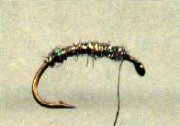 Cover the hook shank with a layer of thread and dub a very small amount of GSS onto your thread. Wrap a very slender body beginning slightly below bend of hook and extending up the shank to a point about three eye lengths back from the eye (this way you’re sure to leave room for the hackle and the head without crowding the eye).
Cover the hook shank with a layer of thread and dub a very small amount of GSS onto your thread. Wrap a very slender body beginning slightly below bend of hook and extending up the shank to a point about three eye lengths back from the eye (this way you’re sure to leave room for the hackle and the head without crowding the eye).
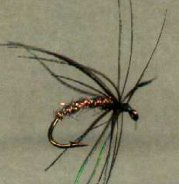 Tie in hackle by butt and take one turn of hackle around the shank. Tie off and trim excess.
Tie in hackle by butt and take one turn of hackle around the shank. Tie off and trim excess.
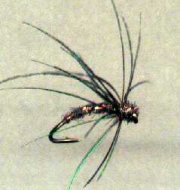 Dub a small amount of GSS onto your thread. Wind this in front of the hackle to form a small head as shown. Whip finish small thread head just behind eye. Fibers from head may then be picked out if desired to make for an even “buggier” appearance.
Dub a small amount of GSS onto your thread. Wind this in front of the hackle to form a small head as shown. Whip finish small thread head just behind eye. Fibers from head may then be picked out if desired to make for an even “buggier” appearance.






